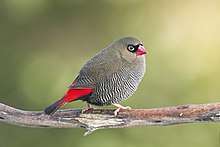Passerea
Passerea is a clade of neoavian birds that was proposed by Jarvis et al. (2014).[1] Their genomic analyis recovered two major clades within Neoaves, Passerea and Columbea, and concluded that both clades appear to have many ecologically driven convergent traits.
| Passerea | |
|---|---|
 | |
| Beautiful firetail (Stagonopleura bella) | |
| Scientific classification | |
| Kingdom: | Animalia |
| Phylum: | Chordata |
| Class: | Aves |
| Infraclass: | Neognathae |
| Clade: | Neoaves |
| Clade: | Passerea Jarvis et al., 2014 |
| Clades | |
According to Jarvis (2014), these convergences include the footpropelled diving trait of grebes in Columbea with loons and cormorants in Passerea; the wading-feeding trait of flamingos in Columbea with ibises and egrets in Passerea; and pigeons and sandgrouse in Columbea with shorebirds (killdeer) in Passerea. For Jarvis (2014), these long-known trait and morphological alliances suggest that some of the traditional nongenomic trait classifications are based on polyphyletic assemblages.
Passerea was not recovered in other studies.[2]
Phylogeny
Cladogram of Passerea relationships based on Jarvis, E.D. et al. (2014)[1] with some clade names after Yuri, T. et al. (2013)[3] and Kimball et al. 2013.[4]
| Passerea |
| ||||||||||||||||||||||||||||||||||||||||||||||||||||||||||||
| Telluraves |
| ||||||||||||||||||||||||||||||||||||||||||||||||||||||||||||||||||||||||
References
- Jarvis, E. D.; Mirarab, S.; Aberer, A. J.; et al. (2014). "Whole-genome analyses resolve early branches in the tree of life of modern birds". Science. 346 (6215): 1320–1331. Bibcode:2014Sci...346.1320J. doi:10.1126/science.1253451. PMC 4405904. PMID 25504713.
- Prum, R.O. et al. (2015) A comprehensive phylogeny of birds (Aves) using targeted next-generation DNA sequencing. Nature 526, 569–573.
- Yuri, T.; et al. (2013). "Parsimony and Model-Based Analyses of Indels in Avian Nuclear Genes Reveal Congruent and Incongruent Phylogenetic Signals". Biology. 2 (1): 419–444. doi:10.3390/biology2010419. PMC 4009869. PMID 24832669.
- Kimball, R.T. et al. (2013) Identifying localized biases in large datasets: A case study using the Avian Tree of Life. Mol Phylogenet Evol. doi:10.1016/j.ympev.2013.05.029
_white_background.jpg)
_(6852440498)_white_background.jpg)


_white_background.jpg)

_white_background.jpg)